brake sensor TOYOTA RAV4 PLUG-IN HYBRID 2023 Owners Manual
[x] Cancel search | Manufacturer: TOYOTA, Model Year: 2023, Model line: RAV4 PLUG-IN HYBRID, Model: TOYOTA RAV4 PLUG-IN HYBRID 2023Pages: 718, PDF Size: 167.55 MB
Page 5 of 718
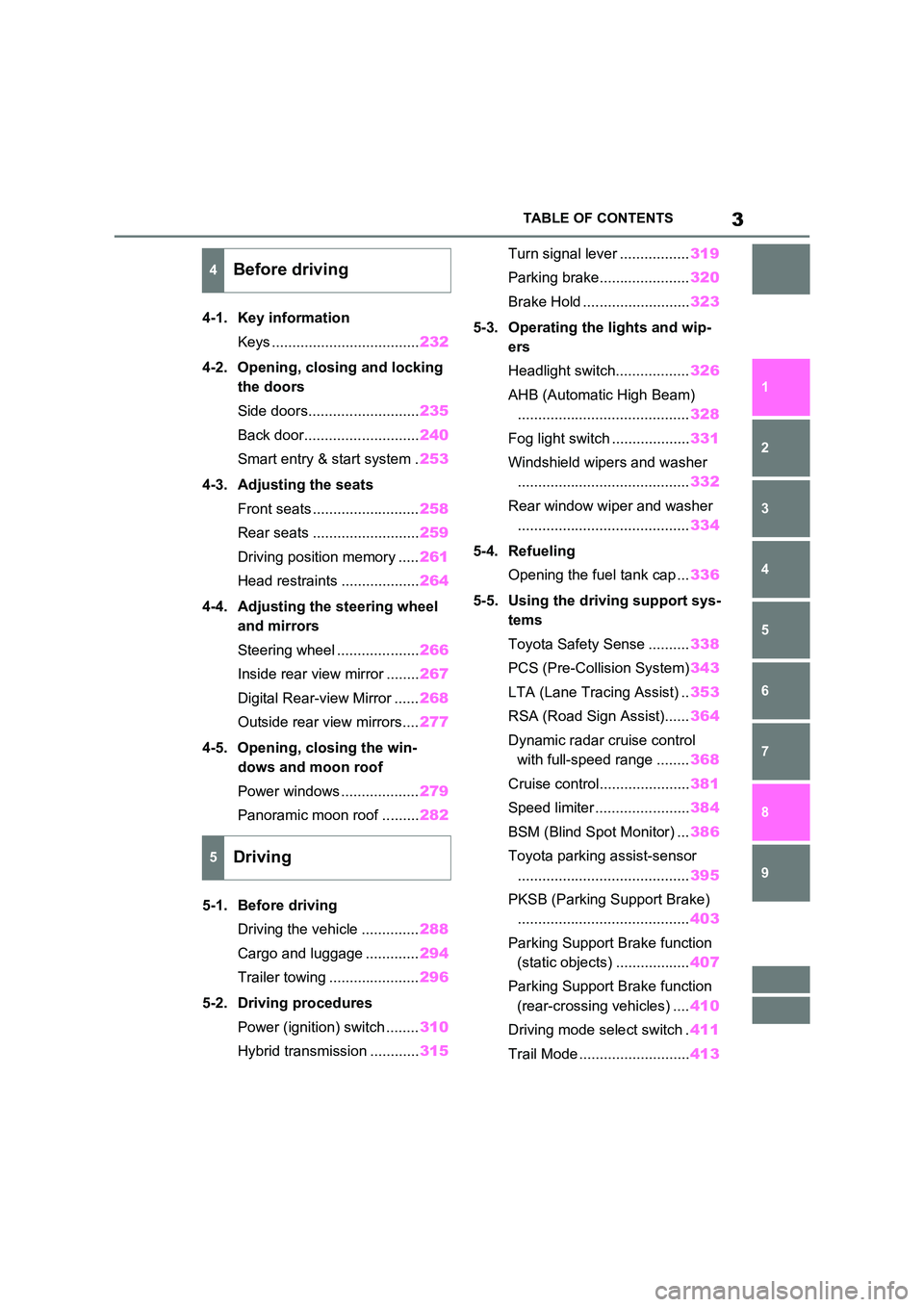
3TABLE OF CONTENTS
1
6
5
4
3
2
8
7
9
4-1. Key information
Keys .................................... 232
4-2. Opening, closing and locking
the doors
Side doors........................... 235
Back door............................ 240
Smart entry & start system . 253
4-3. Adjusting the seats
Front seats .......................... 258
Rear seats .......................... 259
Driving position memory ..... 261
Head restraints ................... 264
4-4. Adjusting the steering wheel
and mirrors
Steering wheel .................... 266
Inside rear view mirror ........ 267
Digital Rear-view Mirror ...... 268
Outside rear view mirrors.... 277
4-5. Opening, closing the win-
dows and moon roof
Power windows ................... 279
Panoramic moon roof ......... 282
5-1. Before driving
Driving the vehicle .............. 288
Cargo and luggage ............. 294
Trailer towing ...................... 296
5-2. Driving procedures
Power (ignition) switch ........ 310
Hybrid transmission ............ 315
Turn signal lever ................. 319
Parking brake...................... 320
Brake Hold .......................... 323
5-3. Operating the lights and wip-
ers
Headlight switch.................. 326
AHB (Automatic High Beam)
.......................................... 328
Fog light switch ................... 331
Windshield wipers and washer
.......................................... 332
Rear window wiper and washer
.......................................... 334
5-4. Refueling
Opening the fuel tank cap ... 336
5-5. Using the driving support sys-
tems
Toyota Safety Sense .......... 338
PCS (Pre-Collision System) 343
LTA (Lane Tracing Assist) .. 353
RSA (Road Sign Assist)...... 364
Dynamic radar cruise control
with full-speed range ........ 368
Cruise control...................... 381
Speed limiter ....................... 384
BSM (Blind Spot Monitor) ... 386
Toyota parking assist-sensor
.......................................... 395
PKSB (Parking Support Brake)
.......................................... 403
Parking Support Brake function
(static objects) .................. 407
Parking Support Brake function
(rear-crossing vehicles) .... 410
Driving mode select switch . 411
Trail Mode ........................... 413
4Before driving
5Driving
Page 43 of 718
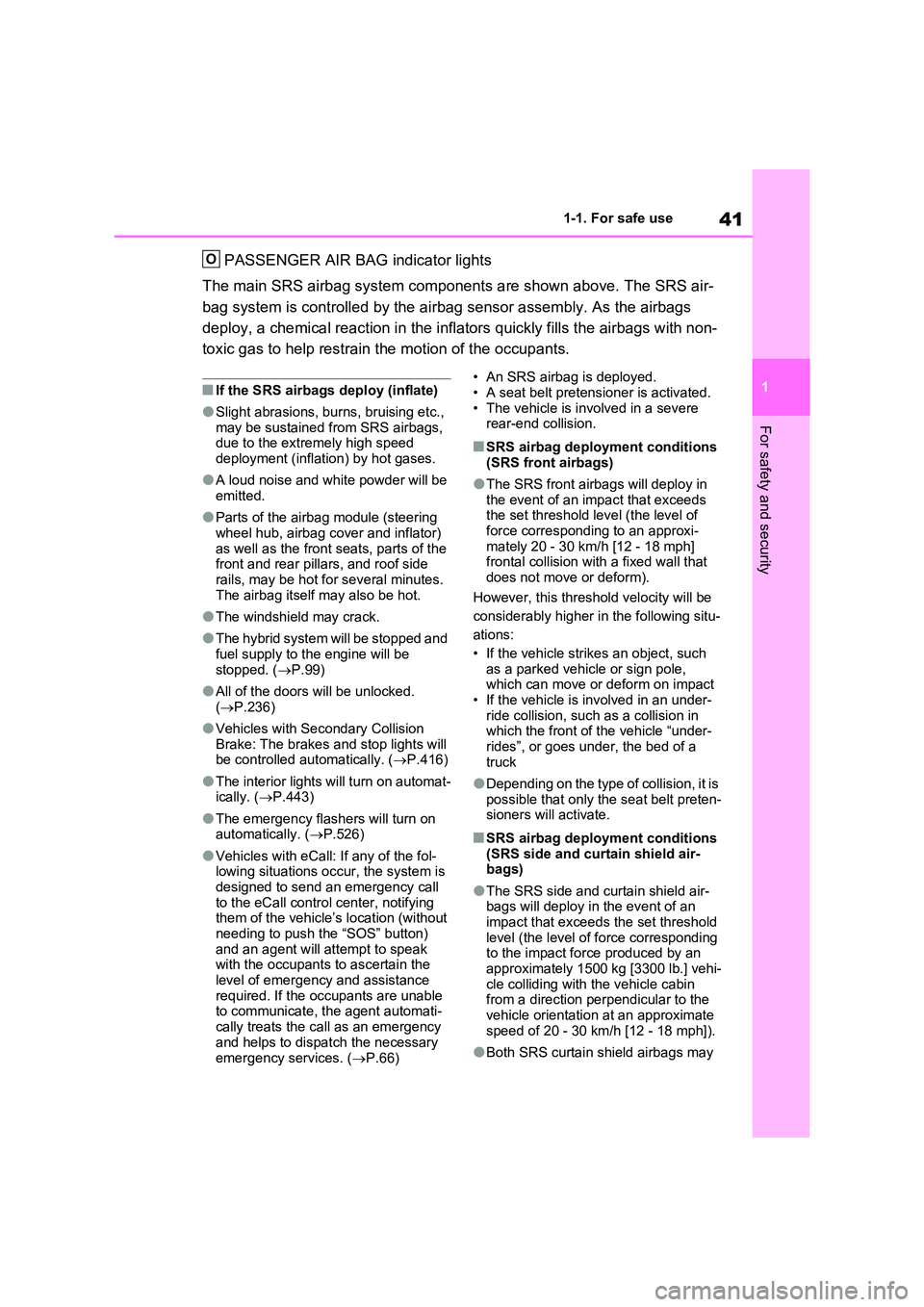
41
1
1-1. For safe use
For safety and security
PASSENGER AIR BAG indicator lights
The main SRS airbag system components are shown above. The SRS air-
bag system is controlled by the airbag sensor assembly. As the airbags
deploy, a chemical reaction in the inflators quickly fills the airbags with non-
toxic gas to help restrain the motion of the occupants.
■If the SRS airbags deploy (inflate)
●Slight abrasions, burns, bruising etc., may be sustained from SRS airbags, due to the extremely high speed
deployment (inflation) by hot gases.
●A loud noise and white powder will be
emitted.
●Parts of the airbag module (steering
wheel hub, airbag cover and inflator) as well as the front seats, parts of the front and rear pillars, and roof side
rails, may be hot for several minutes. The airbag itself may also be hot.
●The windshield may crack.
●The hybrid system will be stopped and
fuel supply to the engine will be stopped. ( P.99)
●All of the doors will be unlocked. ( P.236)
●Vehicles with Secondary Collision Brake: The brakes and stop lights will be controlled automatically. ( P.416)
●The interior lights will turn on automat- ically. ( P.443)
●The emergency flashers will turn on automatically. ( P.526)
●Vehicles with eCall: If any of the fol- lowing situations occur, the system is
designed to send an emergency call to the eCall control center, notifying them of the vehicle’s location (without
needing to push the “SOS” button) and an agent will attempt to speak with the occupants to ascertain the
level of emergency and assistance required. If the occupants are unable to communicate, the agent automati-
cally treats the call as an emergency and helps to dispatch the necessary
emergency services. ( P.66)
• An SRS airbag is deployed. • A seat belt pretensioner is activated.
• The vehicle is involved in a severe rear-end collision.
■SRS airbag deployment conditions
(SRS front airbags)
●The SRS front airbags will deploy in
the event of an impact that exceeds the set threshold level (the level of force corresponding to an approxi-
mately 20 - 30 km/h [12 - 18 mph] frontal collision with a fixed wall that does not move or deform).
However, this threshold velocity will be
considerably higher in the following situ-
ations:
• If the vehicle strikes an object, such as a parked vehicle or sign pole, which can move or deform on impact
• If the vehicle is involved in an under- ride collision, such as a collision in which the front of the vehicle “under-
rides”, or goes under, the bed of a truck
●Depending on the type of collision, it is possible that only the seat belt preten-sioners will activate.
■SRS airbag deployment conditions
(SRS side and curtain shield air- bags)
●The SRS side and curtain shield air-bags will deploy in the event of an impact that exceeds the set threshold
level (the level of force corresponding to the impact force produced by an approximately 1500 kg [3300 lb.] vehi-
cle colliding with the vehicle cabin from a direction perpendicular to the vehicle orientation at an approximate
speed of 20 - 30 km/h [12 - 18 mph]).
●Both SRS curtain shield airbags may
O
Page 185 of 718
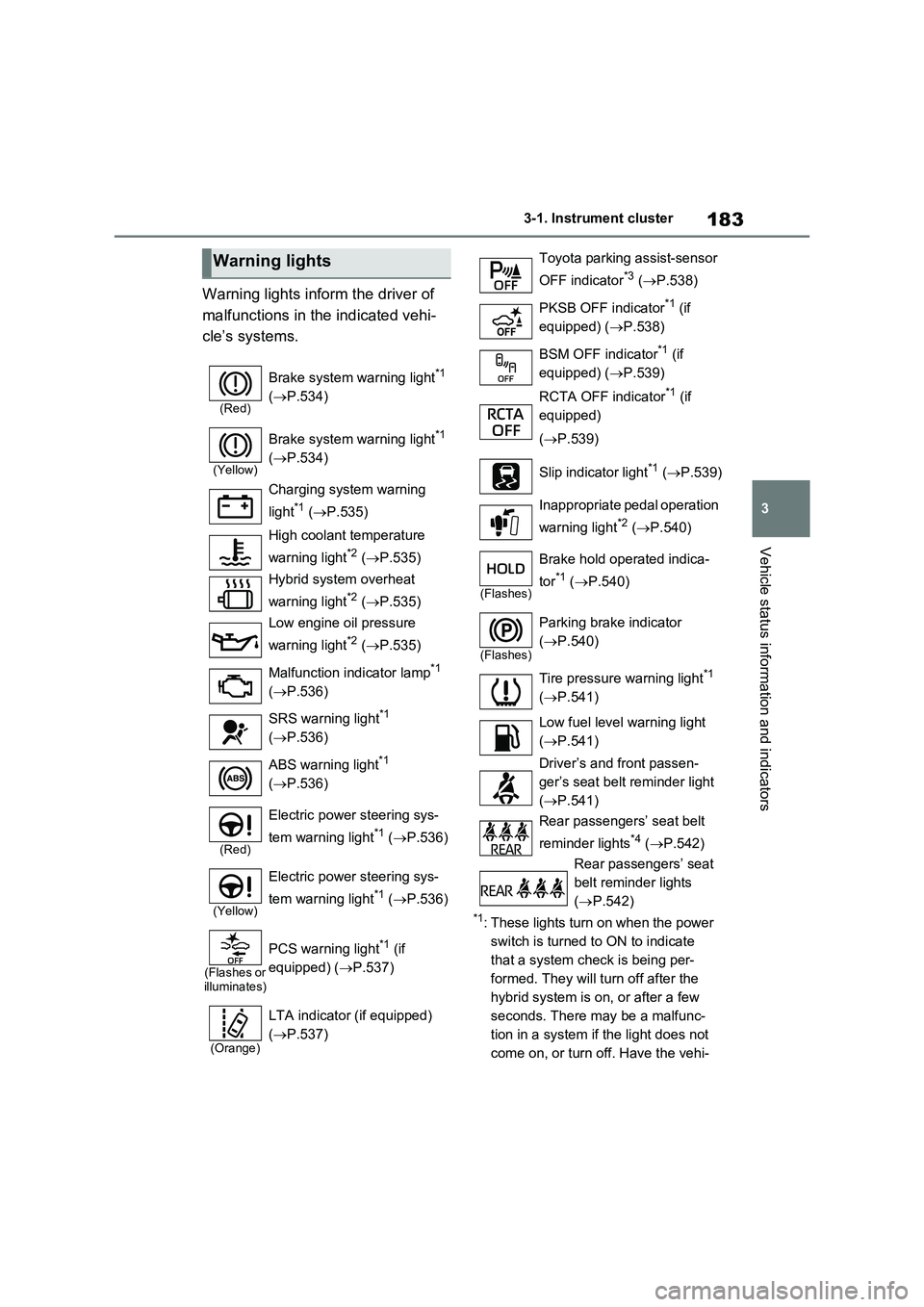
183
3 3-1. Instrument cluster
Vehicle status information and indicators
Warning lights inform the driver of
malfunctions in the indicated vehi-
cle’s systems.
*1: These lights turn on when the power
switch is turned to ON to indicate
that a system check is being per-
formed. They will turn off after the
hybrid system is on, or after a few
seconds. There may be a malfunc-
tion in a system if the light does not
come on, or turn off. Have the vehi-
Warning lights
(Red)
Brake system warning light*1
(P.534)
(Yellow)
Brake system warning light*1
(P.534)
Charging system warning
light
*1 (P.535)
High coolant temperature
warning light
*2 (P.535)
Hybrid system overheat
warning light
*2 (P.535)
Low engine oil pressure
warning light
*2 (P.535)
Malfunction indicator lamp
*1
(P.536)
SRS warning light
*1
(P.536)
ABS warning light
*1
(P.536)
(Red)
Electric power steering sys-
tem warning light
*1 (P.536)
(Yellow)
Electric power steering sys-
tem warning light
*1 (P.536)
(Flashes or
illuminates)
PCS warning light*1 (if
equipped) (P.537)
(Orange)
LTA indicator (if equipped)
(P.537)
Toyota parking assist-sensor
OFF indicator
*3 (P.538)
PKSB OFF indicator
*1 (if
equipped) (P.538)
BSM OFF indicator
*1 (if
equipped) (P.539)
RCTA OFF indicator
*1 (if
equipped)
(P.539)
Slip indicator light
*1 (P.539)
Inappropriate pedal operation
warning light
*2 (P.540)
(Flashes)
Brake hold operated indica-
tor
*1 (P.540)
(Flashes)
Parking brake indicator
(P.540)
Tire pressure warning light
*1
(P.541)
Low fuel level warning light
(P.541)
Driver’s and front passen-
ger’s seat belt reminder light
(P.541)
Rear passengers’ seat belt
reminder lights
*4 (P.542)
Rear passengers’ seat
belt reminder lights
(P.542)
Page 187 of 718
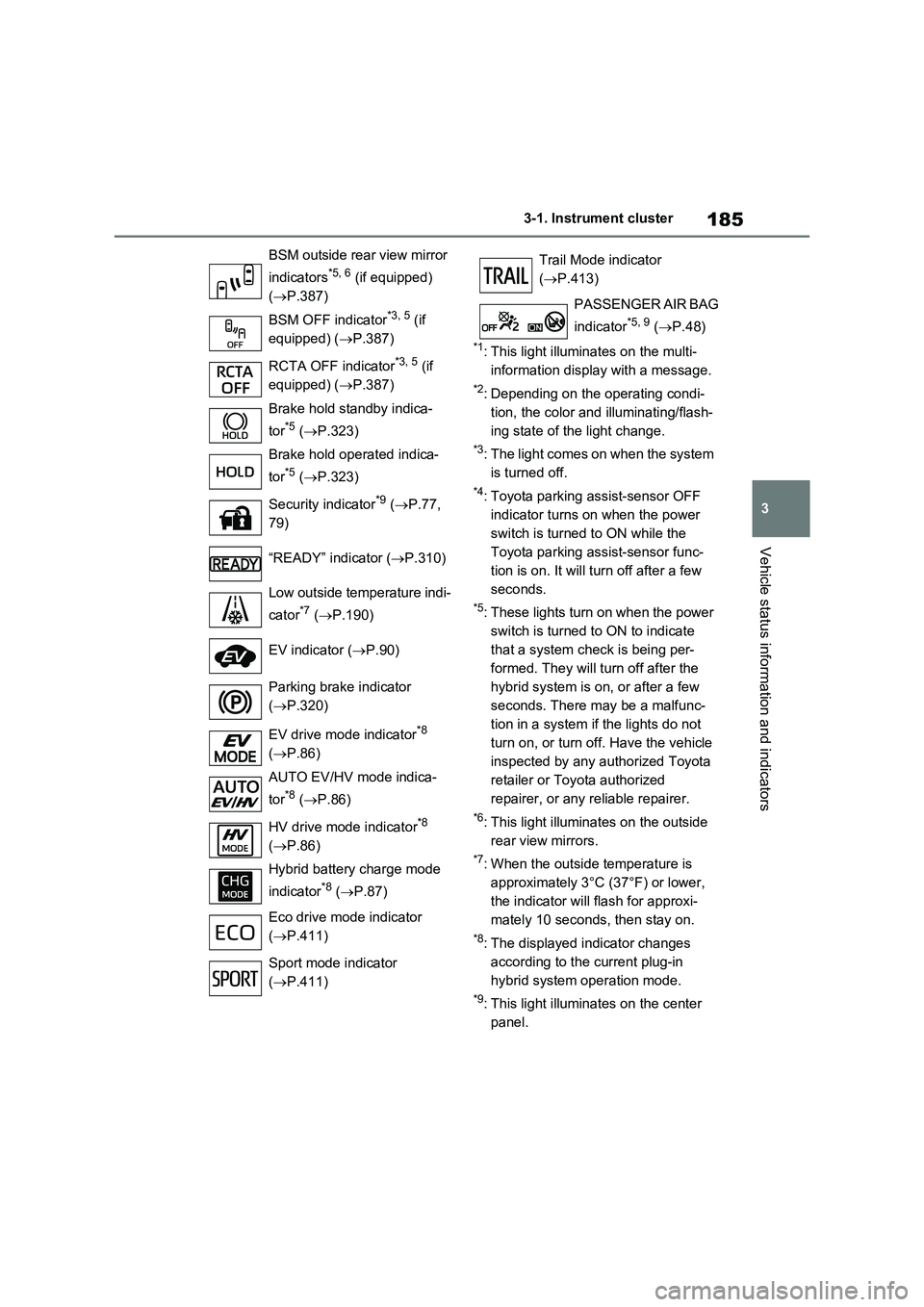
185
3 3-1. Instrument cluster
Vehicle status information and indicators
*1: This light illuminates on the multi-
information display with a message.
*2: Depending on the operating condi-
tion, the color and illuminating/flash-
ing state of the light change.
*3: The light comes on when the system
is turned off.
*4: Toyota parking assist-sensor OFF
indicator turns on when the power
switch is turned to ON while the
Toyota parking assist-sensor func-
tion is on. It will turn off after a few
seconds.
*5: These lights turn on when the power
switch is turned to ON to indicate
that a system check is being per-
formed. They will turn off after the
hybrid system is on, or after a few
seconds. There may be a malfunc-
tion in a system if the lights do not
turn on, or turn off. Have the vehicle
inspected by any authorized Toyota
retailer or Toyota authorized
repairer, or any reliable repairer.
*6: This light illuminates on the outside
rear view mirrors.
*7: When the outside temperature is
approximately 3°C (37°F) or lower,
the indicator will flash for approxi-
mately 10 seconds, then stay on.
*8: The displayed indicator changes
according to the current plug-in
hybrid system operation mode.
*9: This light illuminates on the center
panel. BSM outside rear view mirror
indicators
*5, 6 (if equipped)
(P.387)
BSM OFF indicator
*3, 5 (if
equipped) (P.387)
RCTA OFF indicator
*3, 5 (if
equipped) (P.387)
Brake hold standby indica-
tor
*5 (P.323)
Brake hold operated indica-
tor
*5 (P.323)
Security indicator
*9 (P.77,
79)
“READY” indicator (P.310)
Low outside temperature indi-
cator
*7 (P.190)
EV indicator (P.90)
Parking brake indicator
(P.320)
EV drive mode indicator
*8
(P.86)
AUTO EV/HV mode indica-
tor
*8 (P.86)
HV drive mode indicator
*8
(P.86)
Hybrid battery charge mode
indicator
*8 (P.87)
Eco drive mode indicator
(P.411)
Sport mode indicator
(P.411)
Trail Mode indicator
(P.413)
PASSENGER AIR BAG
indicator
*5, 9 (P.48)
Page 209 of 718
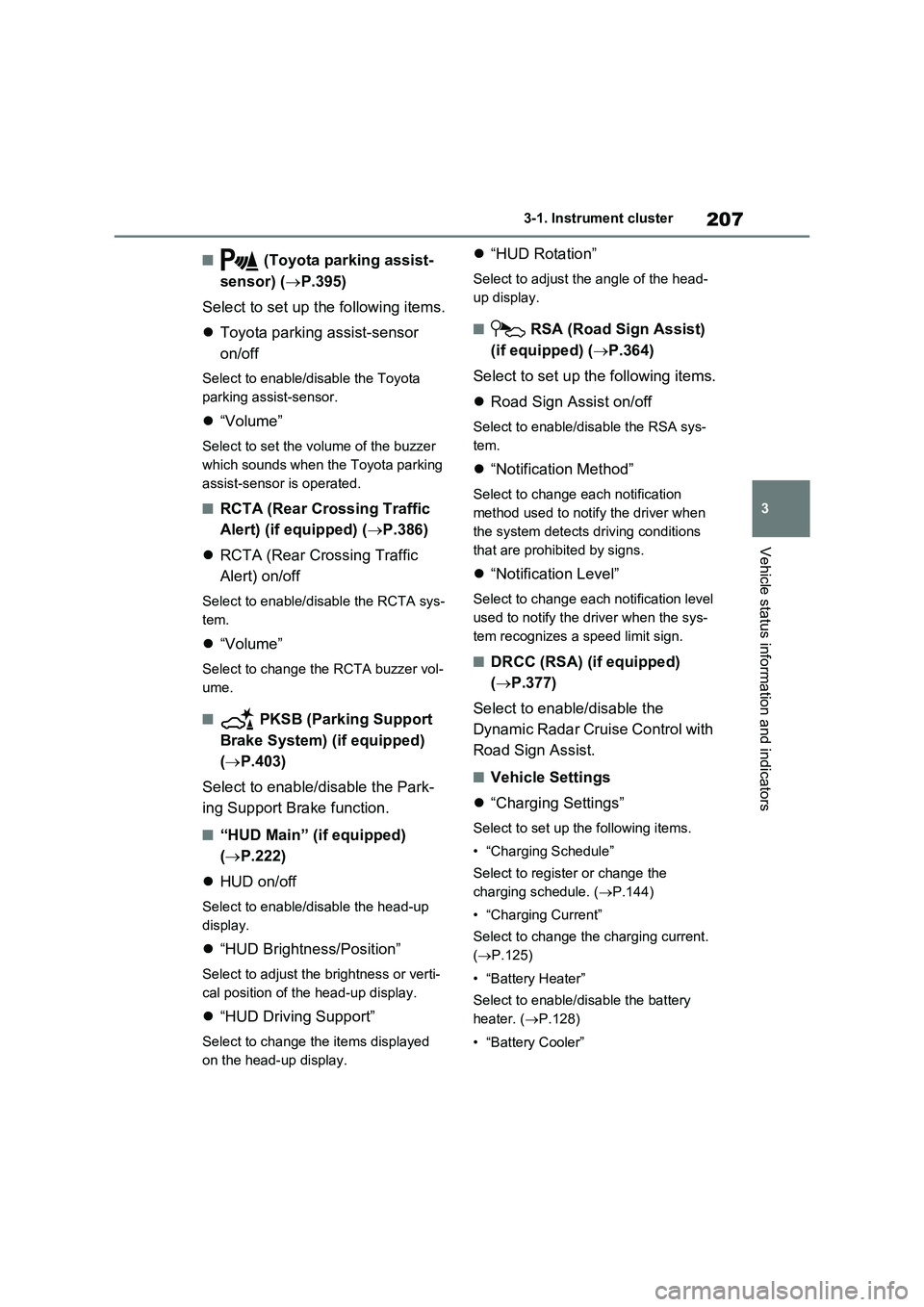
207
3 3-1. Instrument cluster
Vehicle status information and indicators
■ (Toyota parking assist-
sensor) (P.395)
Select to set up the following items.
Toyota parking assist-sensor
on/off
Select to enable/disable the Toyota
parking assist-sensor.
“Volume”
Select to set the volume of the buzzer
which sounds when the Toyota parking
assist-sensor is operated.
■RCTA (Rear Crossing Traffic
Alert) (if equipped) (P.386)
RCTA (Rear Crossing Traffic
Alert) on/off
Select to enable/disable the RCTA sys-
tem.
“Volume”
Select to change the RCTA buzzer vol-
ume.
■ PKSB (Parking Support
Brake System) (if equipped)
(P.403)
Select to enable/disable the Park-
ing Support Brake function.
■“HUD Main” (if equipped)
(P.222)
HUD on/off
Select to enable/disable the head-up
display.
“HUD Brightness/Position”
Select to adjust the brightness or verti-
cal position of the head-up display.
“HUD Driving Support”
Select to change the items displayed
on the head-up display.
“HUD Rotation”
Select to adjust the angle of the head-
up display.
■ RSA (Road Sign Assist)
(if equipped) (P.364)
Select to set up the following items.
Road Sign Assist on/off
Select to enable/disable the RSA sys-
tem.
“Notification Method”
Select to change each notification
method used to notify the driver when
the system detects driving conditions
that are prohibited by signs.
“Notification Level”
Select to change each notification level
used to notify the driver when the sys-
tem recognizes a speed limit sign.
■DRCC (RSA) (if equipped)
(P.377)
Select to enable/disable the
Dynamic Radar Cruise Control with
Road Sign Assist.
■Vehicle Settings
“Charging Settings”
Select to set up the following items.
• “Charging Schedule”
Select to register or change the
charging schedule. (P.144)
• “Charging Current”
Select to change the charging current.
(P.125)
• “Battery Heater”
Select to enable/disable the battery
heater. (P.128)
• “Battery Cooler”
Page 220 of 718
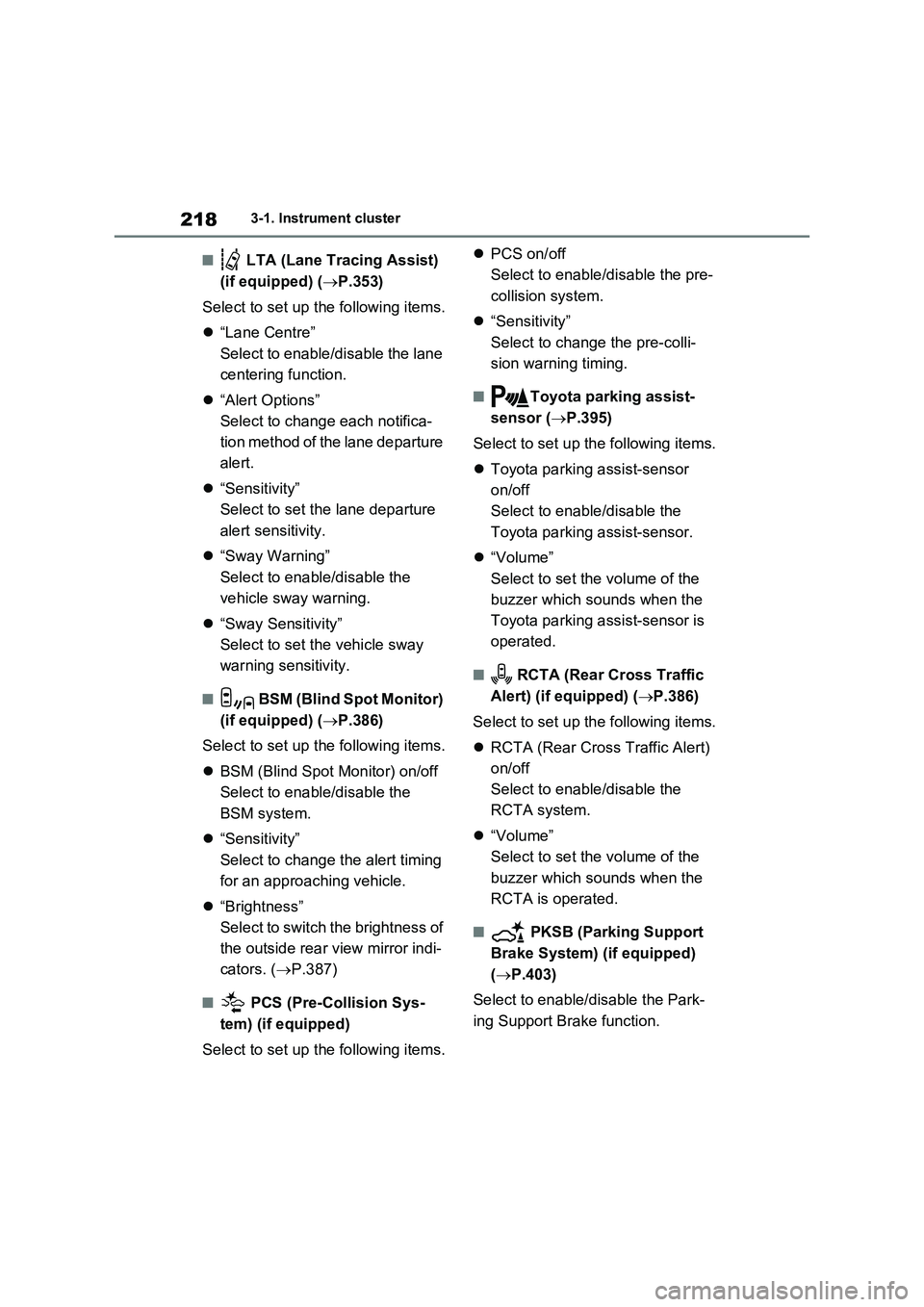
2183-1. Instrument cluster
■ LTA (Lane Tracing Assist)
(if equipped) (P.353)
Select to set up the following items.
“Lane Centre”
Select to enable/disable the lane
centering function.
“Alert Options”
Select to change each notifica-
tion method of the lane departure
alert.
“Sensitivity”
Select to set the lane departure
alert sensitivity.
“Sway Warning”
Select to enable/disable the
vehicle sway warning.
“Sway Sensitivity”
Select to set the vehicle sway
warning sensitivity.
■ BSM (Blind Spot Monitor)
(if equipped) (P.386)
Select to set up the following items.
BSM (Blind Spot Monitor) on/off
Select to enable/disable the
BSM system.
“Sensitivity”
Select to change the alert timing
for an approaching vehicle.
“Brightness”
Select to switch the brightness of
the outside rear view mirror indi-
cators. (P.387)
■ PCS (Pre-Collision Sys-
tem) (if equipped)
Select to set up the following items.PCS on/off
Select to enable/disable the pre-
collision system.
“Sensitivity”
Select to change the pre-colli-
sion warning timing.
■Toyota parking assist-
sensor (P.395)
Select to set up the following items.
Toyota parking assist-sensor
on/off
Select to enable/disable the
Toyota parking assist-sensor.
“Volume”
Select to set the volume of the
buzzer which sounds when the
Toyota parking assist-sensor is
operated.
■ RCTA (Rear Cross Traffic
Alert) (if equipped) (P.386)
Select to set up the following items.
RCTA (Rear Cross Traffic Alert)
on/off
Select to enable/disable the
RCTA system.
“Volume”
Select to set the volume of the
buzzer which sounds when the
RCTA is operated.
■ PKSB (Parking Support
Brake System) (if equipped)
(P.403)
Select to enable/disable the Park-
ing Support Brake function.
Page 248 of 718
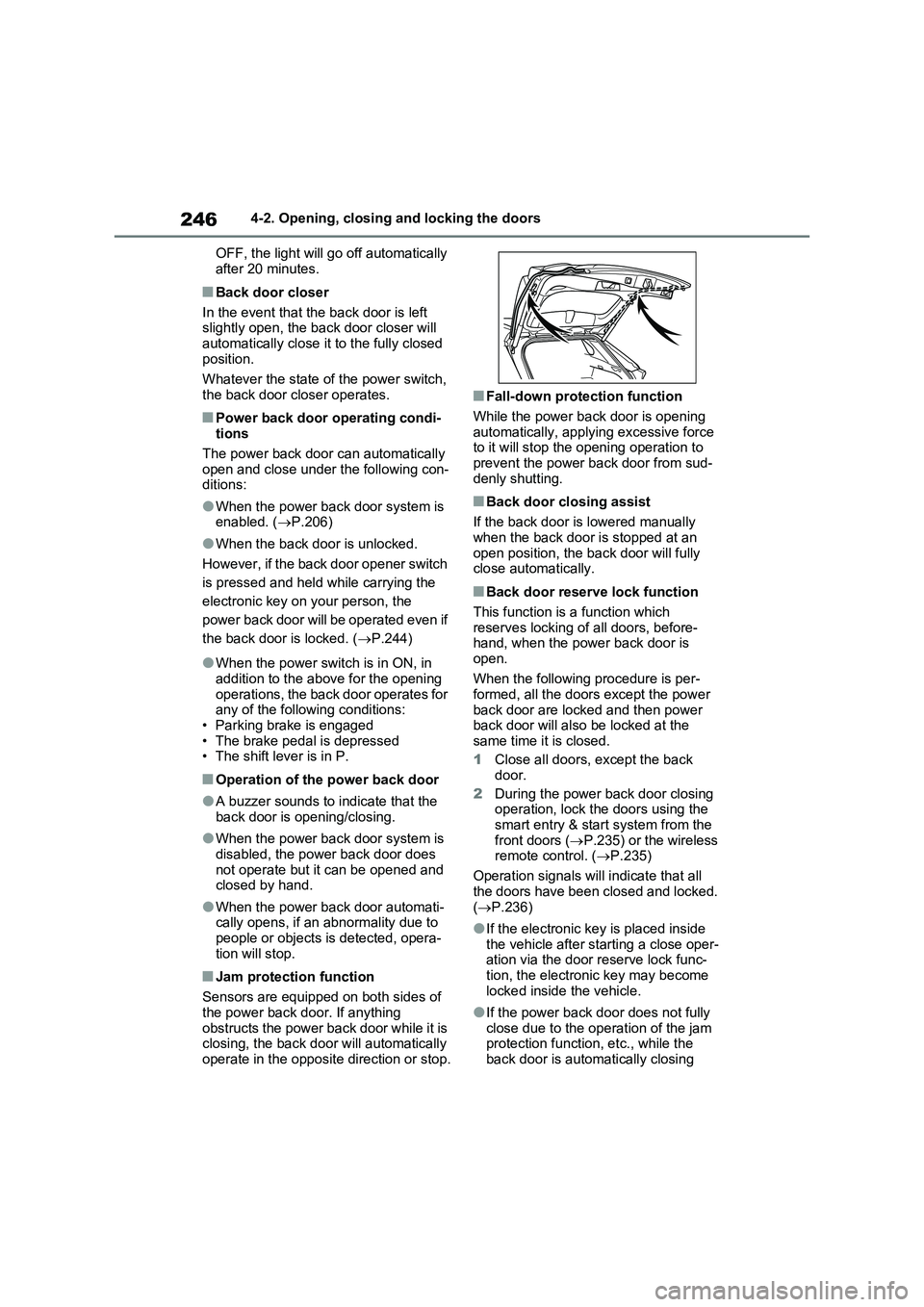
2464-2. Opening, closing and locking the doors
OFF, the light will go off automatically
after 20 minutes.
■Back door closer
In the event that the back door is left
slightly open, the back door closer will
automatically close it to the fully closed
position.
Whatever the state of the power switch,
the back door closer operates.
■Power back door operating condi-
tions
The power back door can automatically
open and close under the following con-
ditions:
●When the power back door system is
enabled. (P.206)
●When the back door is unlocked.
However, if the back door opener switch
is pressed and held while carrying the
electronic key on your person, the
power back door will be operated even if
the back door is locked. (P.244)
●When the power switch is in ON, in
addition to the above for the opening
operations, the back door operates for
any of the following conditions:
• Parking brake is engaged
• The brake pedal is depressed
• The shift lever is in P.
■Operation of the power back door
●A buzzer sounds to indicate that the
back door is opening/closing.
●When the power back door system is
disabled, the power back door does
not operate but it can be opened and
closed by hand.
●When the power back door automati-
cally opens, if an abnormality due to
people or objects is detected, opera-
tion will stop.
■Jam protection function
Sensors are equipped on both sides of
the power back door. If anything
obstructs the power back door while it is
closing, the back door will automatically
operate in the opposite direction or stop.
■Fall-down protection function
While the power back door is opening
automatically, applying excessive force
to it will stop the opening operation to
prevent the power back door from sud-
denly shutting.
■Back door closing assist
If the back door is lowered manually
when the back door is stopped at an
open position, the back door will fully
close automatically.
■Back door reserve lock function
This function is a function which
reserves locking of all doors, before-
hand, when the power back door is
open.
When the following procedure is per-
formed, all the doors except the power
back door are locked and then power
back door will also be locked at the
same time it is closed.
1Close all doors, except the back
door.
2During the power back door closing
operation, lock the doors using the
smart entry & start system from the
front doors (P.235) or the wireless
remote control. (P.235)
Operation signals will indicate that all
the doors have been closed and locked.
(P.236)
●If the electronic key is placed inside
the vehicle after starting a close oper-
ation via the door reserve lock func-
tion, the electronic key may become
locked inside the vehicle.
●If the power back door does not fully
close due to the operation of the jam
protection function, etc., while the
back door is automatically closing
Page 289 of 718
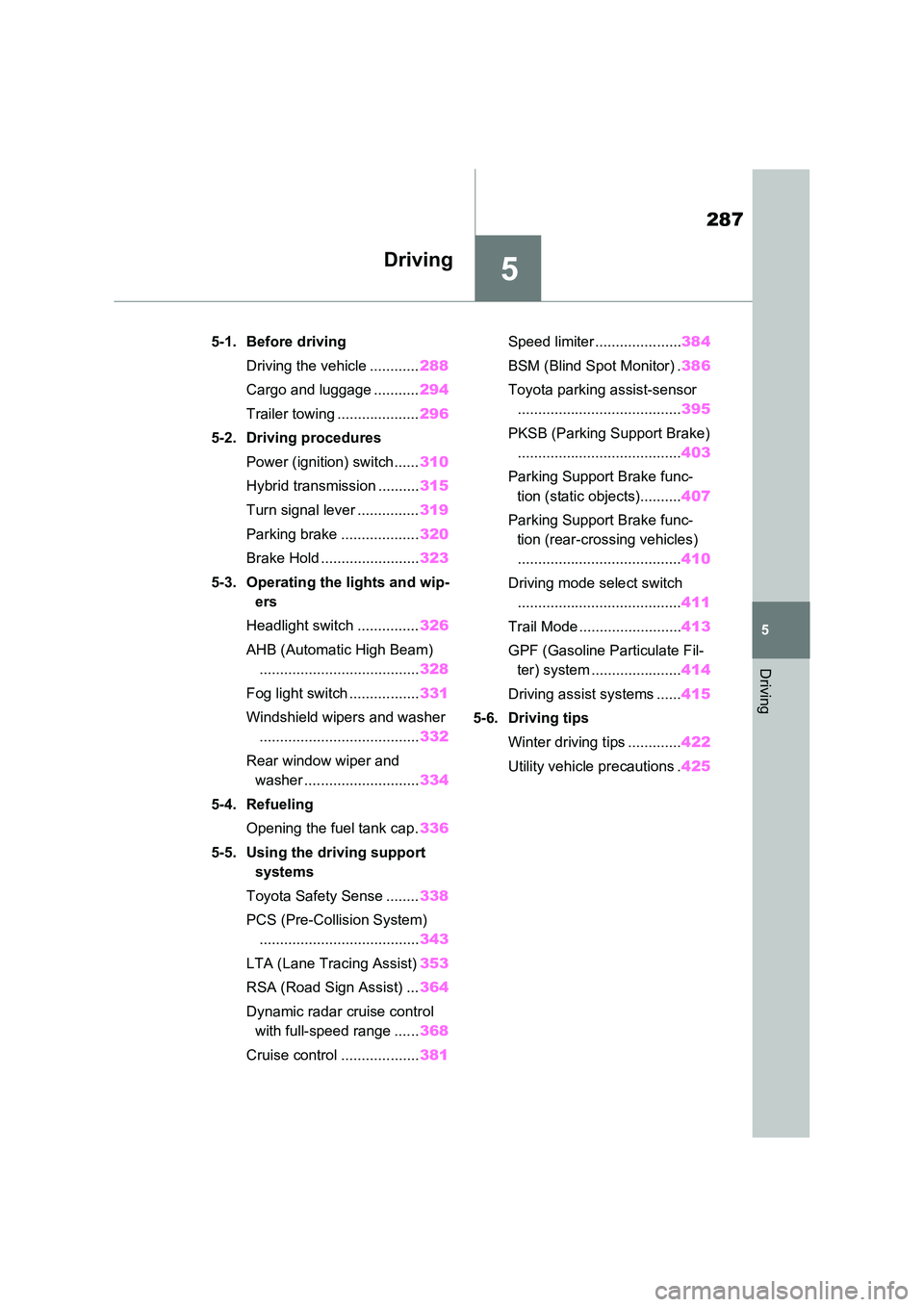
5
287
5
Driving
Driving
5-1. Before driving
Driving the vehicle ............ 288
Cargo and luggage ........... 294
Trailer towing .................... 296
5-2. Driving procedures
Power (ignition) switch ...... 310
Hybrid transmission .......... 315
Turn signal lever ............... 319
Parking brake ................... 320
Brake Hold ........................ 323
5-3. Operating the lights and wip-
ers
Headlight switch ............... 326
AHB (Automatic High Beam)
....................................... 328
Fog light switch ................. 331
Windshield wipers and washer
....................................... 332
Rear window wiper and
washer ............................ 334
5-4. Refueling
Opening the fuel tank cap. 336
5-5. Using the driving support
systems
Toyota Safety Sense ........ 338
PCS (Pre-Collision System)
....................................... 343
LTA (Lane Tracing Assist) 353
RSA (Road Sign Assist) ... 364
Dynamic radar cruise control
with full-speed range ...... 368
Cruise control ................... 381
Speed limiter ..................... 384
BSM (Blind Spot Monitor) . 386
Toyota parking assist-sensor
........................................ 395
PKSB (Parking Support Brake)
........................................ 403
Parking Support Brake func-
tion (static objects).......... 407
Parking Support Brake func-
tion (rear-crossing vehicles)
........................................ 410
Driving mode select switch
........................................ 411
Trail Mode ......................... 413
GPF (Gasoline Particulate Fil-
ter) system ...................... 414
Driving assist systems ...... 415
5-6. Driving tips
Winter driving tips ............. 422
Utility vehicle precautions . 425
Page 298 of 718
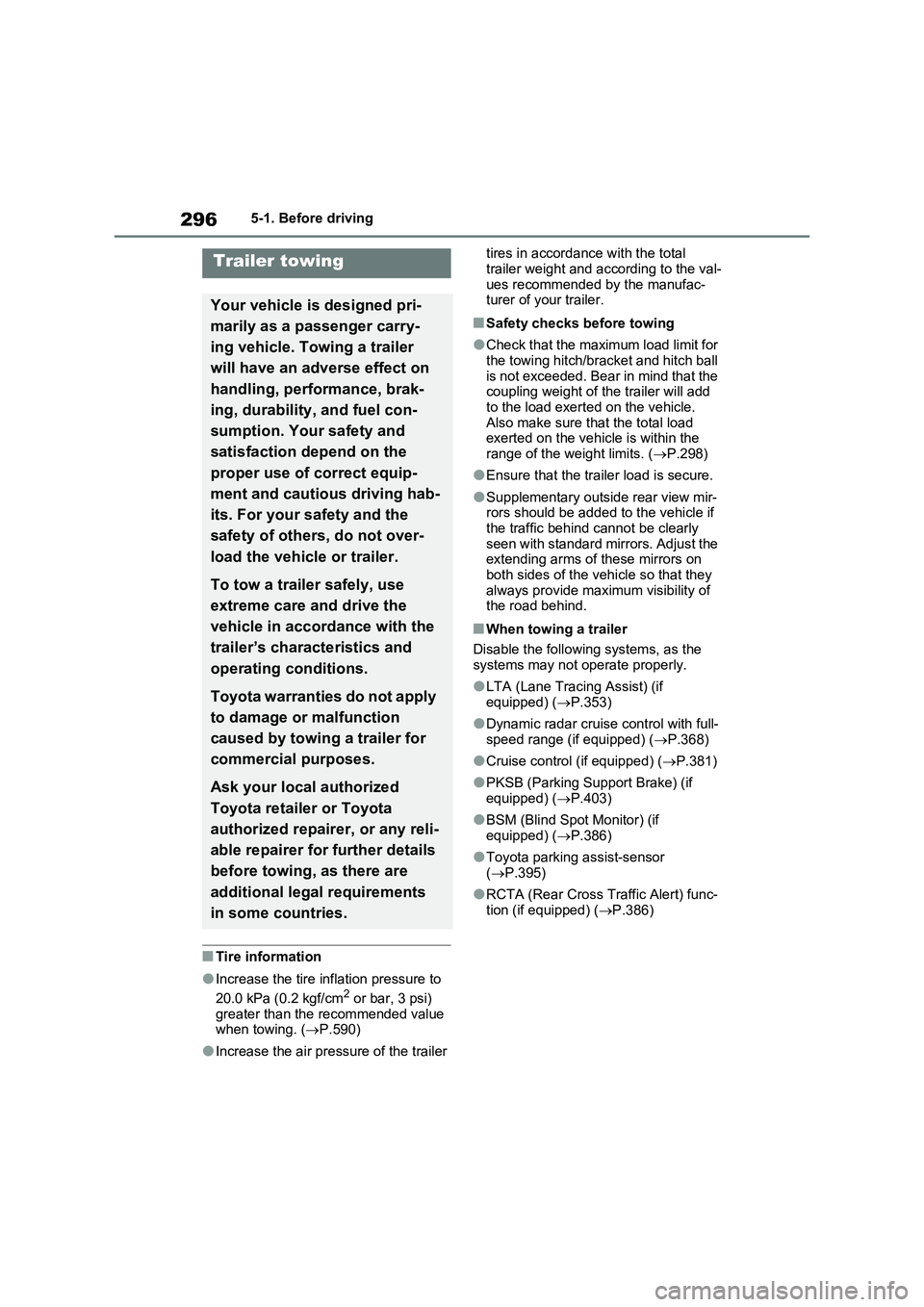
2965-1. Before driving
■Tire information
●Increase the tire inflation pressure to
20.0 kPa (0.2 kgf/cm2 or bar, 3 psi)
greater than the recommended value
when towing. (P.590)
●Increase the air pressure of the trailer tires in accordance with the total
trailer weight and according to the val-
ues recommended by the manufac-
turer of your trailer.
■Safety checks before towing
●Check that the maximum load limit for
the towing hitch/bracket and hitch ball
is not exceeded. Bear in mind that the
coupling weight of the trailer will add
to the load exerted on the vehicle.
Also make sure that the total load
exerted on the vehicle is within the
range of the weight limits. (P.298)
●Ensure that the trailer load is secure.
●Supplementary outside rear view mir-
rors should be added to the vehicle if
the traffic behind cannot be clearly
seen with standard mirrors. Adjust the
extending arms of these mirrors on
both sides of the vehicle so that they
always provide maximum visibility of
the road behind.
■When towing a trailer
Disable the following systems, as the
systems may not operate properly.
●LTA (Lane Tracing Assist) (if
equipped) (P.353)
●Dynamic radar cruise control with full-
speed range (if equipped) (P.368)
●Cruise control (if equipped) (P.381)
●PKSB (Parking Support Brake) (if
equipped) (P.403)
●BSM (Blind Spot Monitor) (if
equipped) (P.386)
●Toyota parking assist-sensor
(P.395)
●RCTA (Rear Cross Traffic Alert) func-
tion (if equipped) (P.386)
Trailer towing
Your vehicle is designed pri-
marily as a passenger carry-
ing vehicle. Towing a trailer
will have an adverse effect on
handling, performance, brak-
ing, durability, and fuel con-
sumption. Your safety and
satisfaction depend on the
proper use of correct equip-
ment and cautious driving hab-
its. For your safety and the
safety of others, do not over-
load the vehicle or trailer.
To tow a trailer safely, use
extreme care and drive the
vehicle in accordance with the
trailer’s characteristics and
operating conditions.
Toyota warranties do not apply
to damage or malfunction
caused by towing a trailer for
commercial purposes.
Ask your local authorized
Toyota retailer or Toyota
authorized repairer, or any reli-
able repairer for further details
before towing, as there are
additional legal requirements
in some countries.
Page 328 of 718
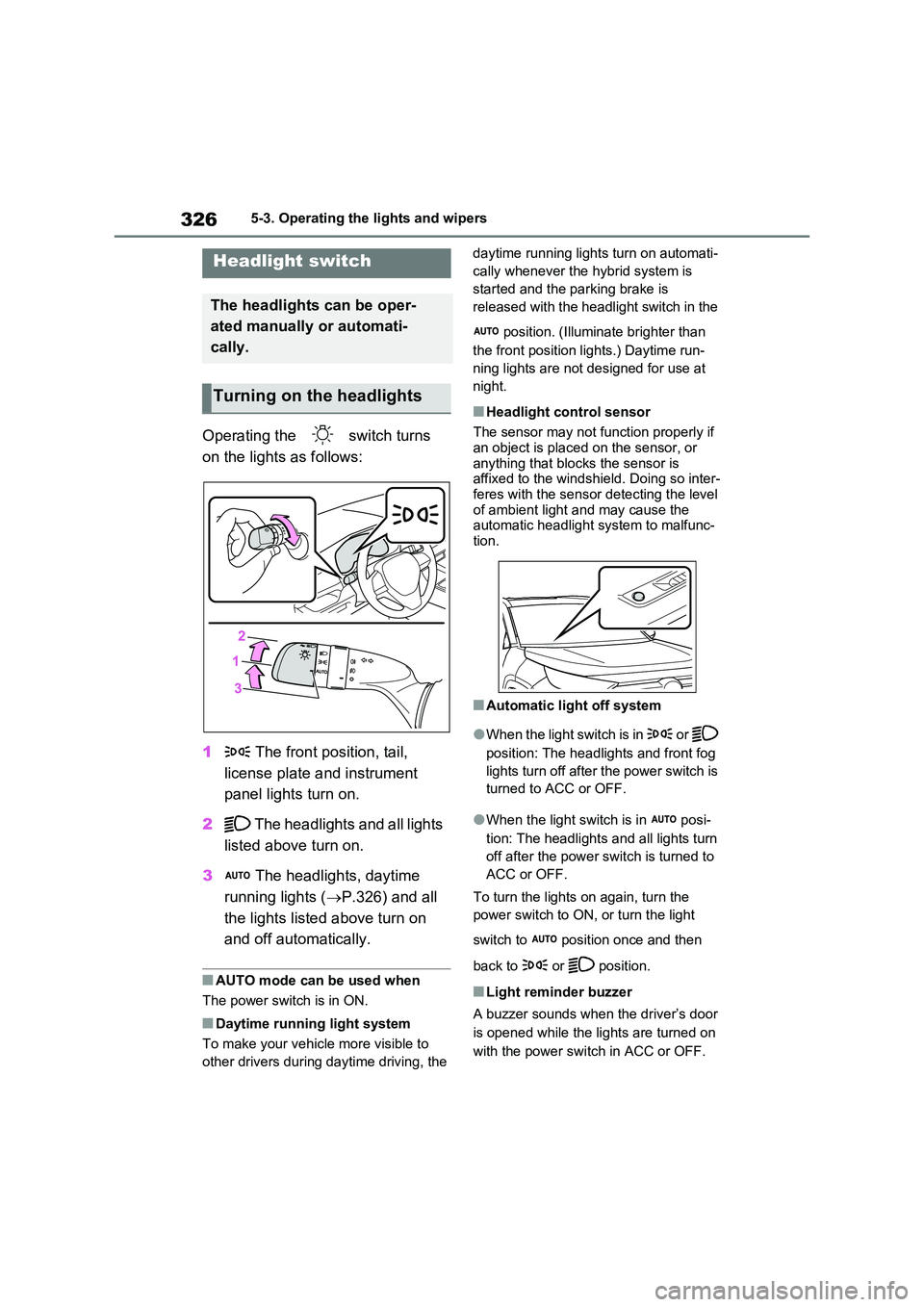
3265-3. Operating the lights and wipers
5-3.Operating the lights and wipers
Operating the switch turns
on the lights as follows:
1 The front position, tail,
license plate and instrument
panel lights turn on.
2 The headlights and all lights
listed above turn on.
3 The headlights, daytime
running lights ( P.326) and all
the lights listed above turn on
and off automatically.
■AUTO mode can be used when
The power switch is in ON.
■Daytime running light system
To make your vehicle more visible to
other drivers during daytime driving, the
daytime running lights turn on automati-
cally whenever the hybrid system is
started and the parking brake is
released with the headlight switch in the
position. (Illuminate brighter than
the front position lights.) Daytime run-
ning lights are not designed for use at
night.
■Headlight control sensor
The sensor may not function properly if an object is placed on the sensor, or
anything that blocks the sensor is affixed to the windshield. Doing so inter-feres with the sensor detecting the level
of ambient light and may cause the automatic headlight system to malfunc-tion.
■Automatic light off system
●When the light switch is in or
position: The headlights and front fog
lights turn off after the power switch is
turned to ACC or OFF.
●When the light switch is in posi-
tion: The headlights and all lights turn
off after the power switch is turned to
ACC or OFF.
To turn the lights on again, turn the
power switch to ON, or turn the light
switch to position once and then
back to or position.
■Light reminder buzzer
A buzzer sounds when the driver’s door
is opened while the lights are turned on
with the power switch in ACC or OFF.
Headlight switch
The headlights can be oper-
ated manually or automati-
cally.
Turning on the headlights